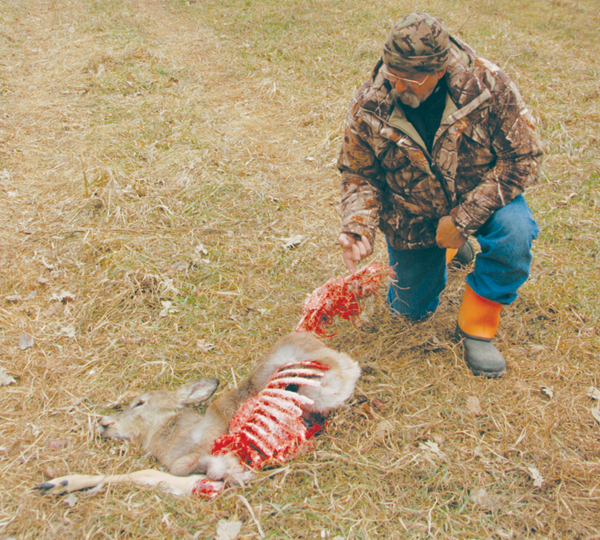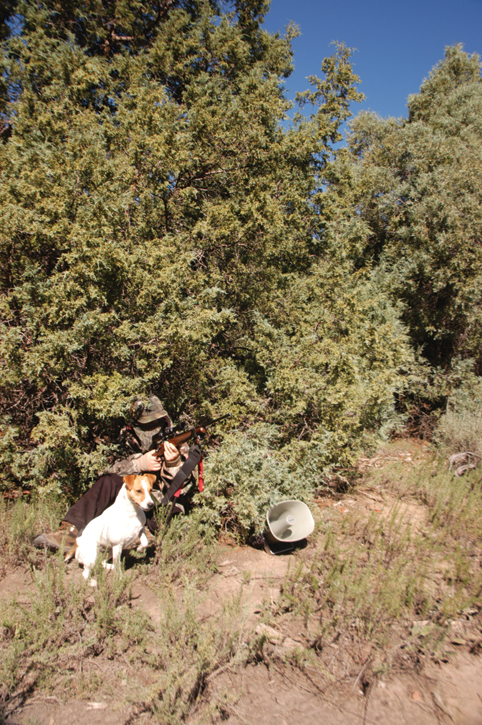 Deer Hunting: Hunting Coyote to Save Deer
Deer Hunting: Hunting Coyote to Save Deer
By Judd Cooney

The hunter sits comfortably encased in a warm body suit, overlooking an acre of standing corn and a half-acre of frosty brassicas, carrots, turnips, rape, and sugar beets. With the coming of winter, deer have been munching heavily on the succulent greens and frost-sweetened tubers to compliment the high-carb corn. The food plot is drawing deer like metal filings to a magnet.
Finally, “the moment of truth” arrives as a big buck eases into the edge of the plot and pauses cautiously, just out of range. But then, scant moments away from the culmination of a year’s planning, hard work and anticipation, howls and yaps reverberate from the woods behind the hunter’s blind, and a coyote dashes out into the field. As the deer turns and bolts for parts unknown, it becomes painfully clear that a major factor of deer management has been overlooked—predator control.
This exact scenario played out a half-dozen times last season at our Iowa hunting leases, and my clients reported coyote sightings and vocalizations on a daily basis. The surge in coyote numbers provided a rude reminder that maybe I’d been a bit lax in the predator control aspect of deer management on my leases.
Several years back, when it first happened to several clients and then to me with only two days of the late season left, I vowed to do something about it. The following spring, I spent every available minute during turkey season calling coyotes, and I took out a half-dozen deer-killing canines. That fall, I bought a $200 nonresident Iowa trapping license and eliminated another 29 from the five farms I lease for deer and turkey hunting.
My deer clients did not report a single coyote encounter that season.
Properly planned food plots can increase the deer potential of hunting areas many times over. During the fall, green clover, rape, chicory, turnips, tyfon and carrots bring in does and fawns followed by rutting bucks. Later in the season, as the weather gets more severe, the deer turn their attention to corn and soybeans while still munching the greens, especially the turnips and beets whose sugar content heightens in freezing weather.
Of course, predacious coyotes are also quick to pick up on the fact that such food plots are concentrating the deer and making them more vulnerable to ambush.

I’ve heard coyotes howl on one side of a food plot during the late evening, and when the deer spooked out the other side, the rest of the pack took up the chase. Humans aren’t the only hunters to plan ambushes, and the more success coyotes have with such tactics, the more regular they become. Not a good situation for people trying to hunt the same deer.
I tell my hunters they are welcome to shoot any coyote they see, but they rarely want to take the chance on spooking a trophy buck in the area. I understand. In fact, I don’t even like to call coyotes on my leases during hunting season. I want those areas, especially the food plots and surrounding woods, to be as free of human interference as possible.
Thankfully, I don’t have to hunt coyotes during deer season, because I can “teach” the coyotes that the areas are danger zones by trapping them and hunting them earlier in the year. When trapping the leases during deer season, I like to make three or four sets in conspicuous places where a trapped coyote will be seen by any other predator working the area.
The surviving coyotes learn to avoid such places. I know from experience that trapping a couple of coyotes around a food plot can greatly reduce the coyote presence in that area.
One might think that a trapped coyote would also spook deer, but I have glassed deer walking within 30 yards of trapped coyotes. Deer ignore coyotes that are not in hunting mode; body language is a major factor in coyote-deer encounters. I also noticed that after trapping a few coyotes around food plots, the remaining coyotes in the area seemed to be less vocal, or maybe I just caught the loud mouths that were scaring the deer.
Fall trapping helps, but undoubtedly, the most effective time to make a real dent in a local coyote population is during April and May, when they are breeding and denning. This is a deadly time for trapping in states that allow year-round predator control coyote trapping. And even more states allow year-round coyote calling and hunting, which can also be especially effective in the springtime.
Be sure to check all applicable laws, to be on the safe and legal side.
Coyote calling is a different game in the spring than in the fall, in that you are often dealing with coyotes that have paired up and established denning areas. They are very territorial and will aggressively challenge any encroaching coyote to drive it away, and howling is by far the most effective method of bringing such coyotes within rifle or shotgun range.
I like to use the siren sound on my electronic caller to pinpoint coyotes during the predawn darkness. This is also an effective sound for locating turkey gobblers. On several occasions, I’ve moved quietly into a denning area and howled in a pair of coyotes at first shooting light and then moved a quarter-mile or so, set up, and called in a turkey gobbler.
Sometimes, coyotes howl in response to owl hoots and turkey yelps. When this happens, I immediately switch to an ever-present mouth howler and drop into predator hunting mode. I’ll trade a dead coyote for a shot at a turkey gobbler every time, although I have trouble convincing my turkey hunting clients to do the same.
Once I locate coyotes, I move in as close as possible without spooking them. It’s better to set up to call from a distance if there’s a chance the coyotes will hear or see your approach. Often, spring calling entails walking a considerable distance to get in just the right place to con coyotes within gun range. Make sure you keep the wind in your favor when setting up. Coyotes responding to howling almost always circle downwind to pick up the scent of what they believe to be another trespassing coyote.
After I get into position on located coyotes, I typically start out with a couple of lone or interrogation howls and then wait 15 minutes for a vocal response or to see a responding coyote. I keep the volume at a level that adequately covers the distance to the coyotes without blowing them off the hillside. After that initial wait, I may use a female invitation howl, pup howl or group howl to get a sense of any coyotes’ location and demeanor. If a coyote answers back with howls, barks or aggressive bark howls, I try to match them sound for sound. If none of this pulls a coyote into gun range, I switch to canine pup sounds or jackrabbit squalls sporadically for another 20 minutes.
At times, a coyote or pair of coyotes appears almost immediately, coming on the dead run. On other occasion, I’ve struck out on located coyotes only to approach the same area from a different direction a few days later and gotten a shot.
Go figure.
I find that coyotes in the Midwest often respond faster than the ones in the more open country of the West, mainly due to the fact that I’m in closer when I call. Consequently, I make sure I’m ready for action before making that first sound.
I like to set an electronic caller 50-100 yards out in front of me, where I enjoy several hundred yards of visibility, especially on the downwind side. If the cover is too thick, I switch to a tighter setup and a 12 gauge loaded with magnum shells of copper-plated BB. Or I may bring a .223 AR, ready for long shots or fast action.
Spring is also the best time to make use of a coyote decoy, as the sight of another coyote is apt to bring an aggressive and territorial coyote on the dead run with all innate caution forgotten. On several occasions, I’ve almost gotten run over.
I’m looking forward to giving the new Fox Bang feature on my FoxPro CS24 electronic caller a workout this spring.
At the sound of a shot, the caller automatically and immediately switches to coyote ki-yi sounds, which work extremely well for halting or even turning coyotes immediately following a shot.
I’ve watched many a missed or second coyote stop, turn, and come back when I started ki-yiing.
Western pro predator hunters like to use live decoy dogs to lure spring coyotes into shooting range. If you ever get a chance to try this, don’t pass it up, ’cause it will give you a whole new perspective on the territoriality of denning coyotes. It’s amazing to watch a decoy dog bring a second coyote back within range after you’ve just shot its mate. They certainly don’t act like the spooky, survival-oriented critters seen in fall and winter.
Every year, I get requests from local hound hunters who want to run coyotes on my deer leases, and while I don’t want a bunch of hounds spooking every deer within hearing during the hunting season, I do let them come back and run the coyotes after deer season closes.
If you hunt deer but don’t trap yourself, you might also consider working with a local trapper to thin the coyotes in your hunting area. No trapper is going to catch all of them, but a good trapper should be able to catch enough to make the rest leery of food plots and other key hunting areas, and a good trapper will know how to do this while keeping the human encroachment factor to a minimum.
Traps should be checked at midday, only, when the deer are least likely to be moving or already in the food plots. This should be an ironclad requirement in any agreement with a trapper. It can be a win-win situation for everyone, but only if everyone is on the same page and the trapper follows the ground rules.
I hunt coyotes in the spring to take the pressure off the deer. Hence, when a pair of coyotes comes to the call, I generally take the female first, as she’s the one whelping the litter that is going to be giving me more trouble later. It may sound hard-hearted, but coyote populations are expanding everywhere, and predator control is a search and destroy mission—one I take very seriously. If you do the same, you may see a big improvement in your deer hunting, too.